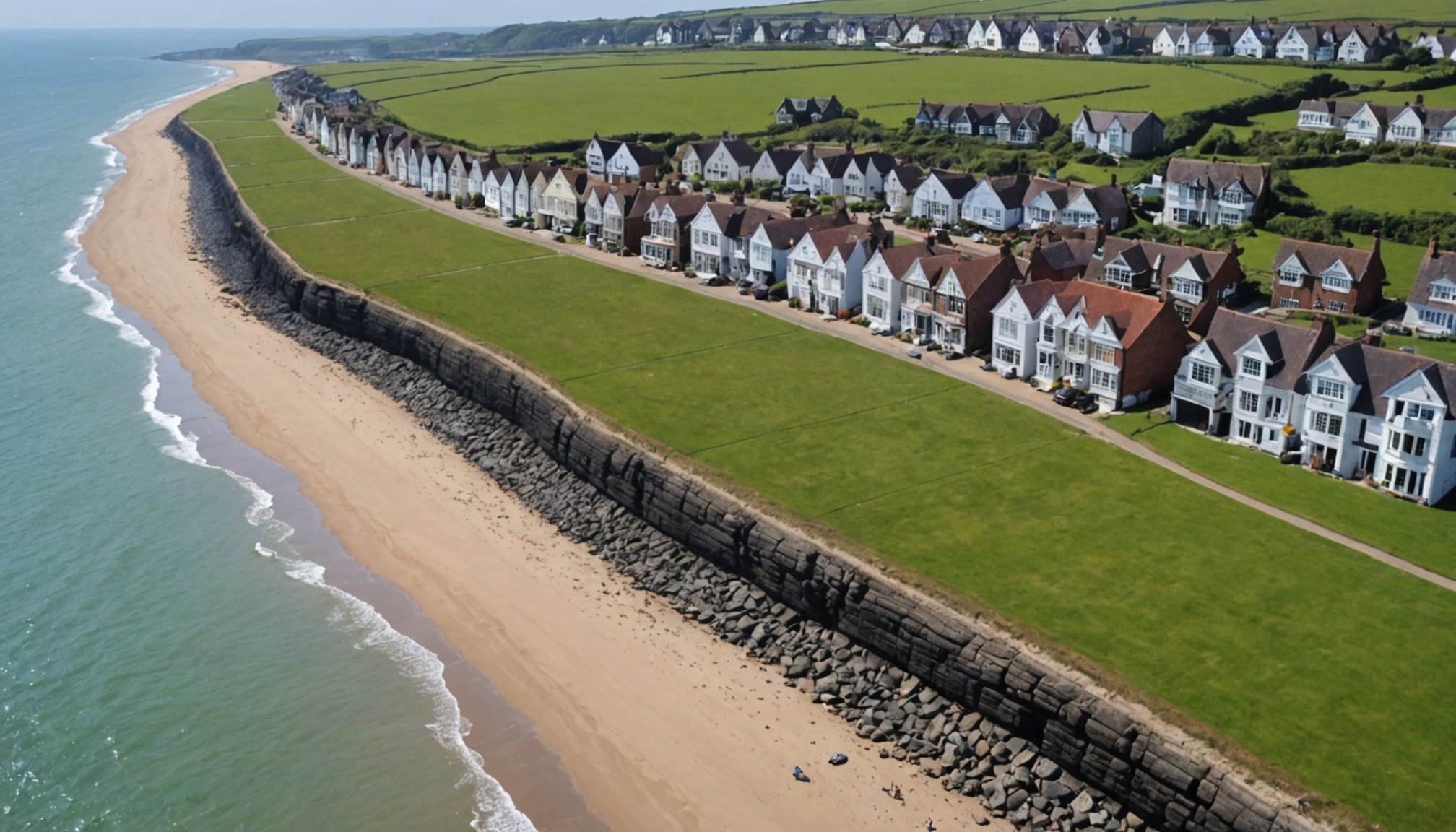Overview of Coastal Erosion in the UK
Coastal erosion is the process by which coastlines are gradually worn away due to natural forces such as waves, tides, and currents. In the UK coastline, coastal erosion has become a pressing issue threatening both the landscape and beachfront properties. This natural phenomenon is influenced by factors including rising sea levels and human activities like construction and deforestation, which exacerbate the situation.
Recent statistics highlight alarming trends. The UK’s coastlines, particularly in vulnerable areas, have witnessed increased rates of erosion. Studies estimate that around 1,800 miles of the UK coastline are at risk, translating to significant losses in terms of land and property. For citizens owning beachfront properties, these trends mean potentially substantial economic impacts, with reduced property values and increased maintenance costs becoming a reality.
Also read : How Does the UK Property Market Influence Financial Credit Decisions?
Addressing coastal erosion is vital for property owners to safeguard their assets and for communities to preserve the environment. Implementing preventive measures, such as constructing sea defences and promoting sustainable development, helps mitigate damage. Furthermore, raising public awareness and engagement remains crucial for effective coastal protection. Understanding these dynamics allows property owners to make informed decisions and plan appropriate risk management strategies.
Coastal Erosion Policies in the UK
Understanding the historical perspective on coastal erosion management in the UK is essential for grasping the evolution of current policies. Since the late 20th century, government focus has shifted toward sustainable approaches, recognising the need for balance between development and environmental protection. Historical evidence points to various policies adjusting to increased erosion threats driven by climate change and rising sea levels.
Topic to read : How Can Homebuyers Maximize Their Savings in the Current UK Property Market?
Today’s coastal management policies in the UK comprise a comprehensive framework addressing erosion’s multifaceted challenges. The UK legislation integrates risk assessments and strategic planning to safeguard vulnerable coastlines. This encompasses protective measures, scientific research, and collaboration with local communities. More recently, adaptive management strategies have been prominent, constantly evolving with new information about coastal dynamics.
Government bodies play a pivotal role in policy enforcement. A mix of national and local authorities work collaboratively, ensuring regulations are adhered to and effectively implemented. Collaboration aims to enhance coastal protection and prepare communities for concerning erosion trends. These government regulations not only aim to prevent further erosion but also encourage sustainable development and involve public participation in safeguarding coastal regions.
Legal Implications for Beachfront Property Owners
Understanding the legal framework surrounding property ownership is crucial for owners residing along coastlines threatened by coastal erosion. In the UK, property rights are defined in relation to the shifting landscapes caused by erosion, often resulting in complex legal challenges.
Property boundaries may change as coastlines retract, leading to potential disputes between property owners and government bodies. Such disputes often arise due to uncertainties in the law over ownership of eroded land, resulting in litigation and adjustments to property rights. The legal system addresses these changes through case laws, providing precedents for resolving conflicts, yet ambiguity still persists over certain aspects.
One crucial aspect of this legal interplay is the potential for erosion impact claims. Property owners may seek compensation when their land diminishes due to erosion. However, proving liability can be particularly challenging, with factors such as natural causes and human activity contributing to the erosion process. Examining relevant case laws reflects the court’s complex balancing act between environmental protection and safeguarding ownership rights.
Property owners are encouraged to familiarise themselves with recent legal developments and engage proactively with legal experts to navigate these challenges effectively. This proactive approach can aid in resolving disputes and managing their assets in light of coastal erosion threats.
Economic Impact of Coastal Erosion
The economic consequences of coastal erosion on the UK coastline significantly influence property value and beachfront investments. As erosion advances, properties once boasting premier locations suffer depreciating market values. The attractiveness of beachfront properties dwindles due to their increased susceptibility to environmental threats, leading to limited demand and thereby diminishing prices.
The economic costs involved extend beyond mere property depreciation. Maintenance costs for affected properties escalate as owners strive to protect their assets from the encroaching seas. Additionally, the potential loss of property, either partially or wholly, to coastal erosion poses substantial financial burdens. Loss of land translates into lost investments, leaving property owners with challenging financial dilemmas.
Investments in beachfront properties in eroding areas show marked trends. Savvy investors, wary of the risks, often seek strategic locations less prone to erosion, compelling a shift in investment patterns. Nonetheless, some investors perceive opportunities in undervalued properties, banking on future protection measures or policy shifts to safeguard their interests.
Understanding these trends and preparing for the prospective impacts are crucial for property owners grappling with economic threats posed by erosion. Proactive risk management and informed decision-making become essential in navigating the volatile property market.
Future of Coastal Erosion Management
The future of coastal erosion management lies in devising sustainable solutions that effectively tackle this escalating issue. Innovations such as nature-based methods are gaining traction. By integrating understanding from real-life case studies, approaches like mangrove planting and salt marsh restoration aim to reinforce natural barriers against erosion. These environmentally friendly methods are proving cost-effective and durable over time.
Policy evolution is essential in responding to emerging challenges. As climate change alters coastlines, the UK must adapt its frameworks. Foresight into policy shifts predicts increased emphasis on adaptive management practices. These include integrating community feedback and leveraging technology for dynamic solutions. Such policies help address both immediate and long-term erosion effects, mixing traditional techniques with modern advancements for comprehensive coastal defence.
Community engagement and public awareness remain crucial in future management. Educational campaigns and participatory planning ensure transparency. They empower those affected to contribute to preserving their environments. Organisations continue to foster collaborations, reinforcing the dialogue between scientists, policymakers, and the public. These interactions encourage innovative practices, driving positive change in coastal protection globally. By committing to these adaptive and inclusive strategies, the UK positions itself at the forefront of combating coastal erosion.
Practical Advice for Property Owners
Navigating the challenges posed by coastal erosion requires strategic action from property owners. Implementing proactive measures is vital to mitigate the impact of erosion. Key strategies include reinforcing existing coastal protection with structures like sea walls and revetments, which act as barriers against advancing waves and tides. Additionally, maintaining vegetation near coastlines can provide a natural defence, helping absorb wave energy and reduce erosion.
Engaging with local authorities and experts is crucial for comprehensive risk management. Authorities often provide guidance on legal regulations and offer resources that address property-specific needs. For example, they may propose suitable protective measures or suggest optimal property adaptations.
Legal framework navigation poses its own set of challenges. Owners are encouraged to access available resources, such as legal advisory services, to understand property rights and liabilities associated with coastal erosion. Proactive engagement ensures better preparation for potential disputes and helps property owners make informed decisions.
Utilising these strategies and leveraging expert advice allows property owners to stay ahead of erosion threats. Access to up-to-date information and active participation in community initiatives ensures that owners can protect their assets and preserve their investments in the face of changing UK coastline dynamics.
Case Studies of Coastal Erosion and Property Ownership
Real-life examples of coastal erosion provide critical insights into the consequences faced by beachfront property owners along the UK coastline. A notable example is the village of Happisburgh in Norfolk, which has seen dramatic erosion rates. Properties here have been documented as victims of retreating coastlines, severely affecting property values and sparking debates over compensation and relocation.
These case studies highlight the urgency of addressing beachfront loss. They illustrate how rapidly eroding coastlines can displace communities, leading to socio-economic challenges. The financial burden on owners unable to resell affected properties or afford adaptive measures is significant, reinforcing the need for effective coastal management policies.
Lessons learned from these examples emphasize the importance of robust communication between policymakers and communities. Many studies document instances where local voices have influenced policy decisions, resulting in initiatives like managed retreat or enhanced coastal defence schemes. It underscores the efficacy of integrating community responses into planning, allowing for adaptive and inclusive frameworks tailored to localised conditions.

